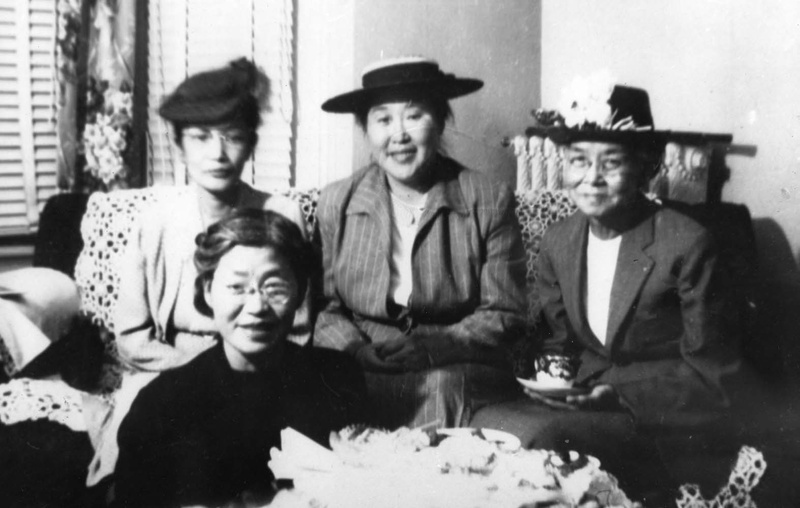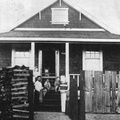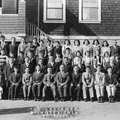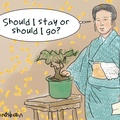Barb Miiko Gravlin "They went fishing on their honeymoon."
Barb Miiko Gravlin’s mother, Yachiyo, grew up on Selkirk Street with her parents, Uhei and Tachi Miike, who were from Kumamoto prefecture. Many Japanese Canadian communities tended to have people from a particular area, but the issei in Marpole came from all over Japan.
Yachiyo was the eldest of the seven children in Vancouver. An older sister Hatsuko had been left with relatives in Japan. Because of the War, they weren’t able to reunite.
According to records from the Custodian of Enemy Property as revealed by the Landscapes of Injustice Project, the Miike family owned the house. They had recently added an extra room to accommodate the family, when they were forced to move. In the backyard, they had five fruit trees and kept chickens, which seems to have been not unusual.
The three Miike brothers were quite athletic and their names appeared often in the New Canadian newspaper articles for basketball and baseball.
Yachiyo married Kinzaburo Nishimura in 1931 when she was 19. She had met him while working at a bakery on Powell Street, where he was a driver. When they first met, they were both engaged to other people. She had been betrothed to a much older man she had no interest in. He was engaged to a woman who ended up dying of meningitis.
“She was considered quite attractive, but she chose my father, who was short. They went fishing on their honeymoon and my mother froze because my father was an avid fisherman.”
Liz Nunoda: "There was this thing called the Boys Brigade"
Liz Nunoda’s father Arthur Asao Nunoda, grew up in Marpole with his parents, Soichi and Sue Nunoda, who were from Shimano prefecture. Sue was probably a picture bride and when Arthur was born, his birth certificate said that she was 24 and Soichi was 36.
Soichi and Sue ran the Powell Bakery on Powell street. They would go to the shop at midnight to start baking the bread and cookies. When Arthur was old enough, he took the Interurban to work as a clerk. The public transportation made Marpole convenient for getting to other places.
At one point in the 1930s, her grandfather was president of the Marpole Japanese school, which seems to have been important to many of the Japanese Canadian families in Marpole.
Her father had two older brothers, Jim and Tak.
“There was this thing called the Boys Brigade. We’ve got photographs of my Uncle Tak and Uncle Jim in uniform, like a group photo of a bunch of nisei. The Boys Brigade was kind of like Cadets, but they didn't allow Japanese in the regular Cadets. This fellow my dad called Captain MacGillivary, he got this idea to have an all nisei Boy's Brigade… My dad talked about him a lot. He was very kind. He was born in Scotland. In the group photos, he was always wearing his regalia with the kilt and everything. My dad sampled haggis.”
Her father had other interests of his own.
“He loved jazz piano and he used to take lessons. His parents sent him to lessons with a nisei instructor, a woman. So he'd go dutifully to his classical piano lessons, but then he said, he'd sneak off and go to jazz piano lessons with a fellow named Joe Williams. My dad's passion was jazz piano. So they had a piano in their house. He saved up to buy one, a parlor upright. He had a cardboard keyboard to practice on before he could afford to pay for the real piano.”
The two older brothers both passed away in the same year in the late 1930s. Jim of tuberculosis and Tak, from falling through the ice at Deer Lake in Burnaby while skating. Soichi heard about this and drove out looking for the area.
“And when he got there, he fainted, he passed out. And the same thing with my grandmother, she fainted when she found out as well. So that was a big tragedy, but a lot of families had a lot of tragedy in their lives.”
Wendy Matsubuchi: "Acknowledging this history is important to the healing of survivors"
Content warning: The following passage references childhood sexual abuse
One of the most challenging aspects of telling the story of the Japanese Canadians in Marpole was how to deal with the crimes of one of its prominent residents, Gordon Goichi Nakayama. We could not ignore what happened, but we also did not wish it to be the only thing to say about the Marpole community. To acknowledge the difficult and ongoing work, Wendy Matsubuchi made a statement on behalf of the Japanese Canadian Working Group.
“The childhood home of Joy Kogawa, currently known as Kogawa House, was owned by Joy’s father, Gordon Goichi Nakayama. Mr. Nakayama said he sexually abused about three hundred boys over a sixty year period, while a minister of the Anglican Church of Canada. The victims of Mr. Nakayama’s clergy sexual abuse include Japanese Canadian families who were living in the Marpole area before the outbreak of World War II. Those suffering under Mr. Nakayama’s abuse include not only the survivors, but also their families, friends, descendants who now live across Canada as well as overseas, where Mr. Nakayama also served as priest.
“The Japanese Canadian Working Group encourages Kogawa House to work with the greater Japanese Canadian community to help the healing process for those individuals and families affected by Mr. Nakayama’s actions as we understand that acknowledging this history is important to the healing of survivors, their families, and the greater community.”
The Anglican Church of Canada issued a public apology and set up a Healing Fund for Japanese Canadians through the National Association of Japanese Canadians. We sincerely hope that survivors can find the support to heal that they require.
Laura Fukumoto "What would it have been like at that time?"
Laura Fukumoto’s grandfather, Fujio Fukumoto, lived with four siblings and her great grandparents, Toyemon and Umechiyo Fukumoto, on Selkirk Street in Marpole. Toyemon worked at the Sawarne lumber mill.
Laura grew up in Ontario, but now lives in Marpole. She never met grandfather or great-grandparents who had once lived in the neighbourhood that is now her own.
And her grandfather was estranged from her father and grandmother, and they would not talk about him. She said,
“In my work as a theatre artist and as a poet, I often do come back to these questions about my family and generally, I try to approach with curiosity and with imagining what it might have been like to live in Vancouver, and travel through Vancouver, and to live in Marpole, and visit your friend on Powell Street, and maybe catch a baseball game on Powell Street. What would it have been like at that time? That's a lot of the magic of theatre and of exploring history is bringing those images and those questions to life.”
Documents from the Custodian of Enemy Property revealed through the Landscapes of Injustice, went through the evaluation of the home of the Fukumotos. “I read through those files recently and that showed the appraisal of the house which I can only describe as biased and racist.”
She also found documents that her grandfather Fujio was a store clerk according to the BC Purchasers Association. “There's this photo of a man standing in front of some women's coats in some kind of department store and he looks an awful lot like my Dad.” But when she tried to ask her grandmother about him, she was evasive.
Laura remains curious and hopeful to find more about her Japanese Canadian ancestors.
“So it’s so interesting to imagine that my grandparents, or my grandfather, and my great aunts and uncles, all went on that exact same bus ride, or streetcar ride. It makes you know that history is so much more present and alive than you can imagine at first, when you're actually physically standing here.”
*This article was originally published in Nikkei Image, 2002 Spring, Volume 27, No. 1.
© 2022 Raymond Nakamura






